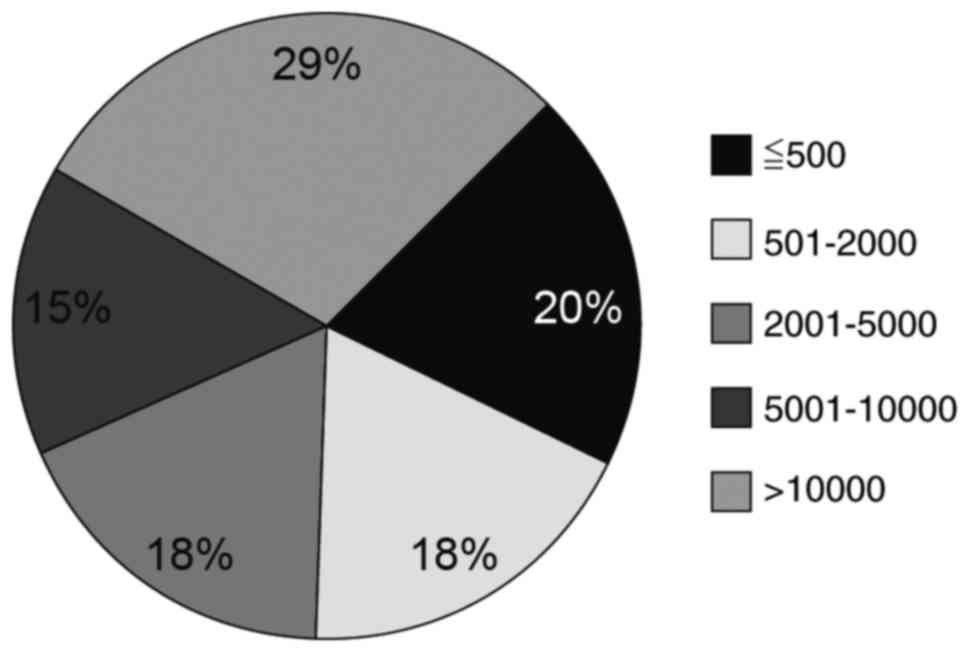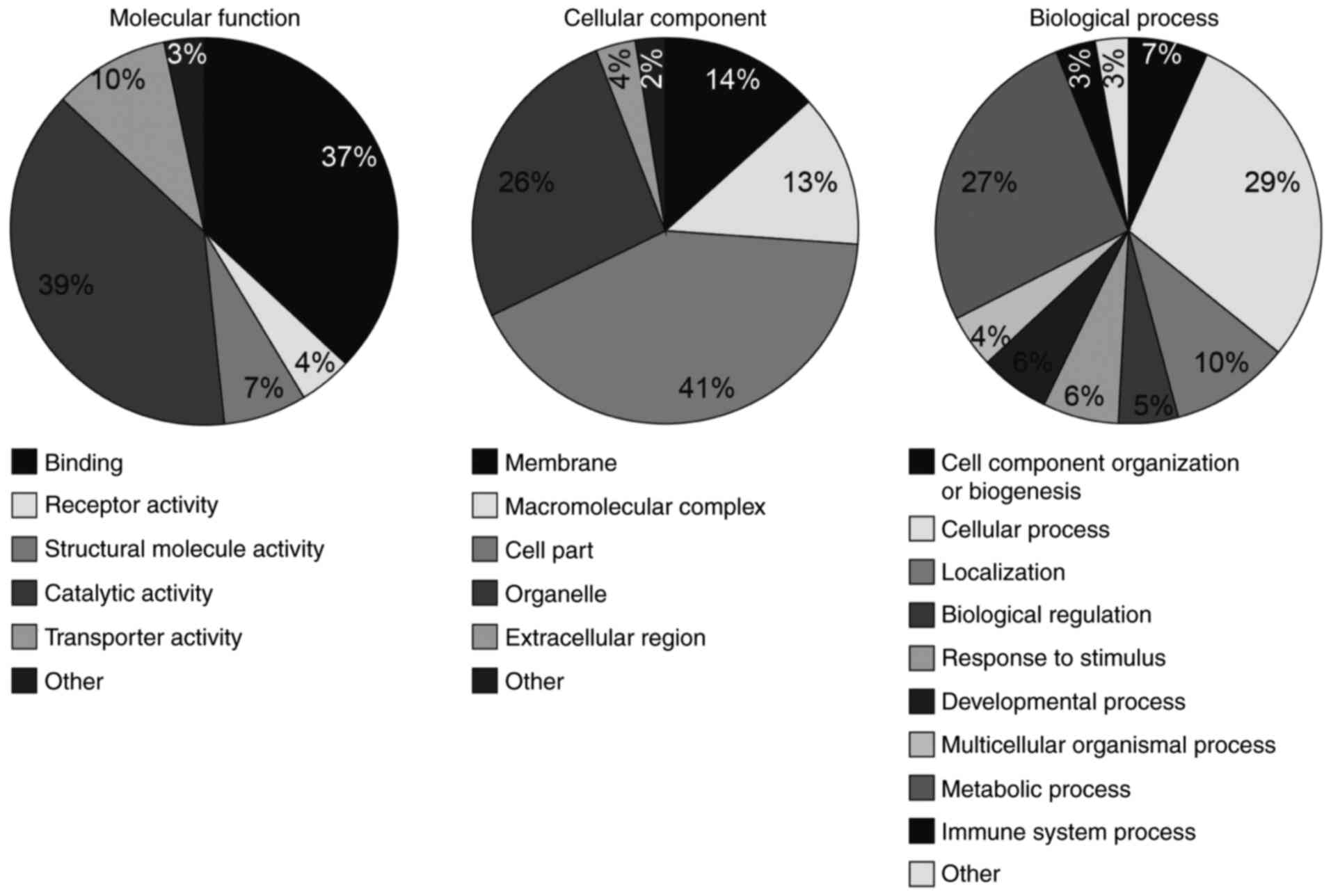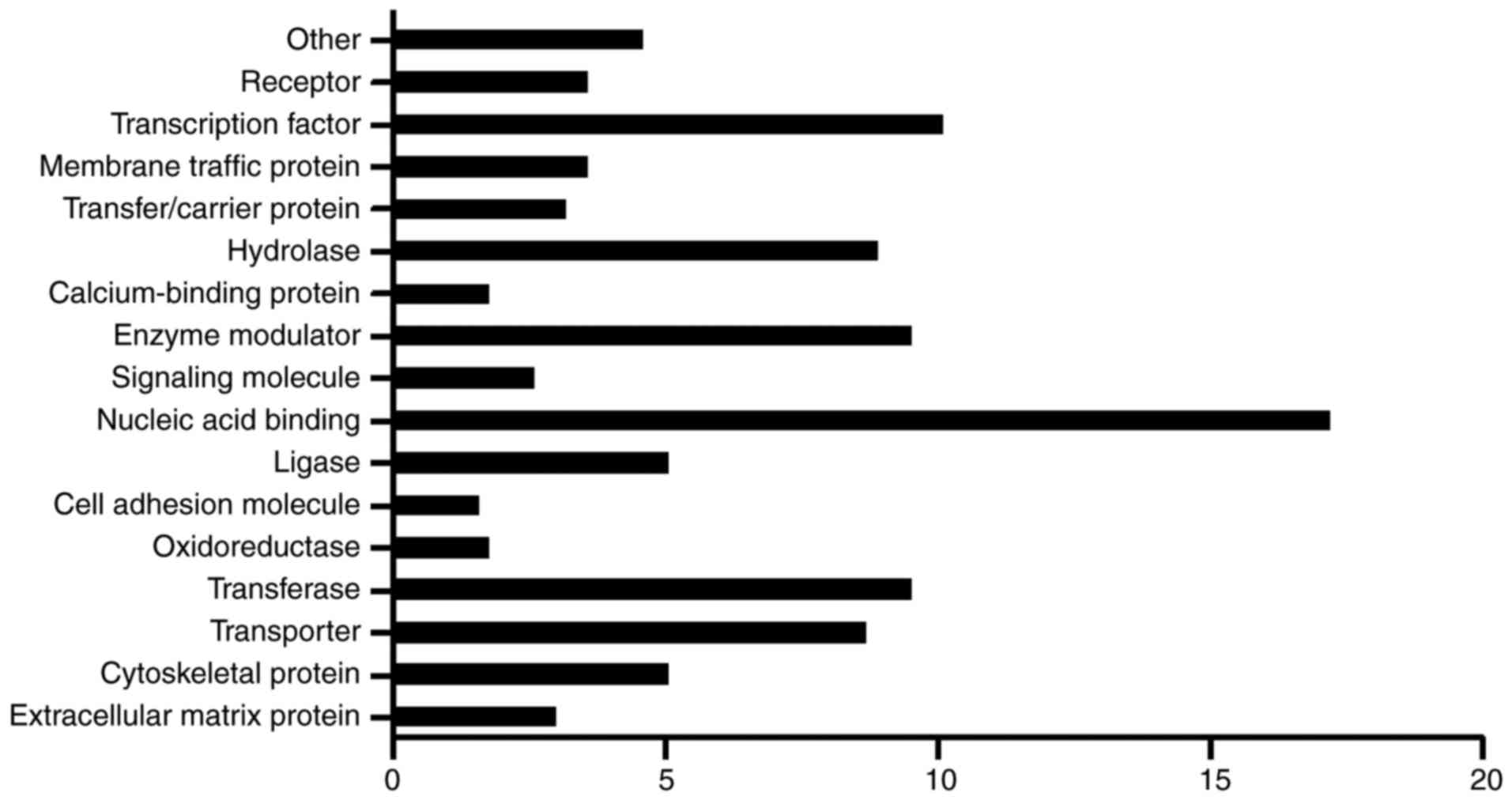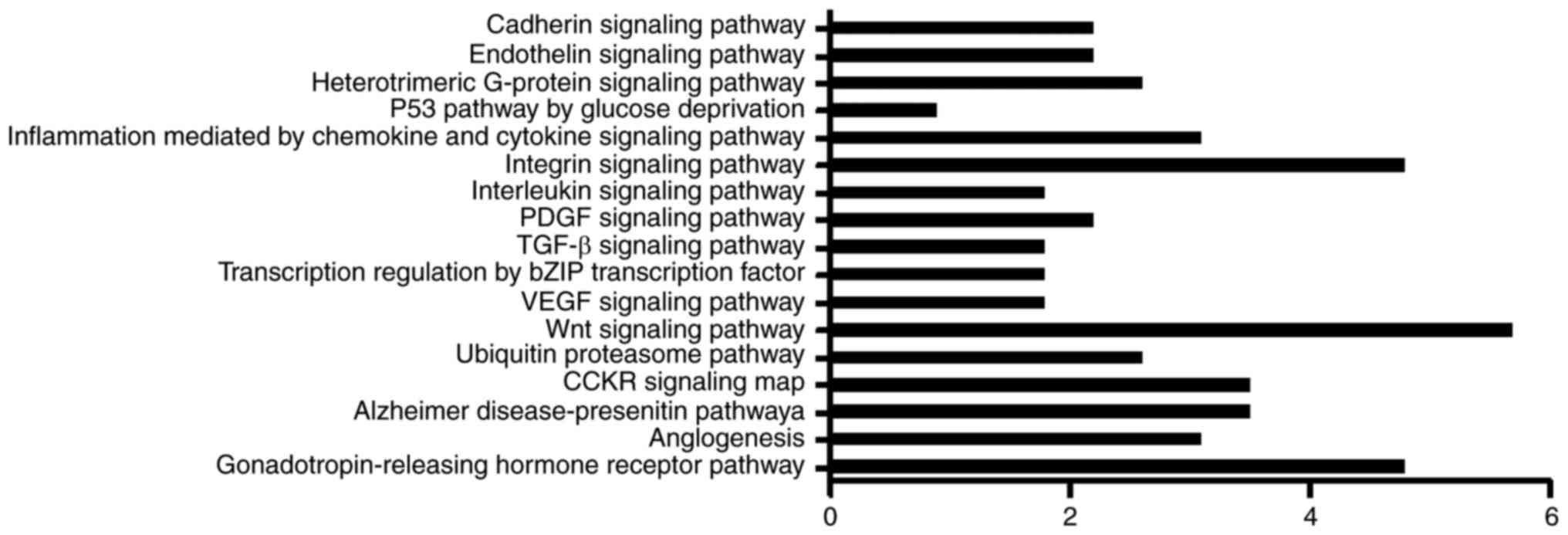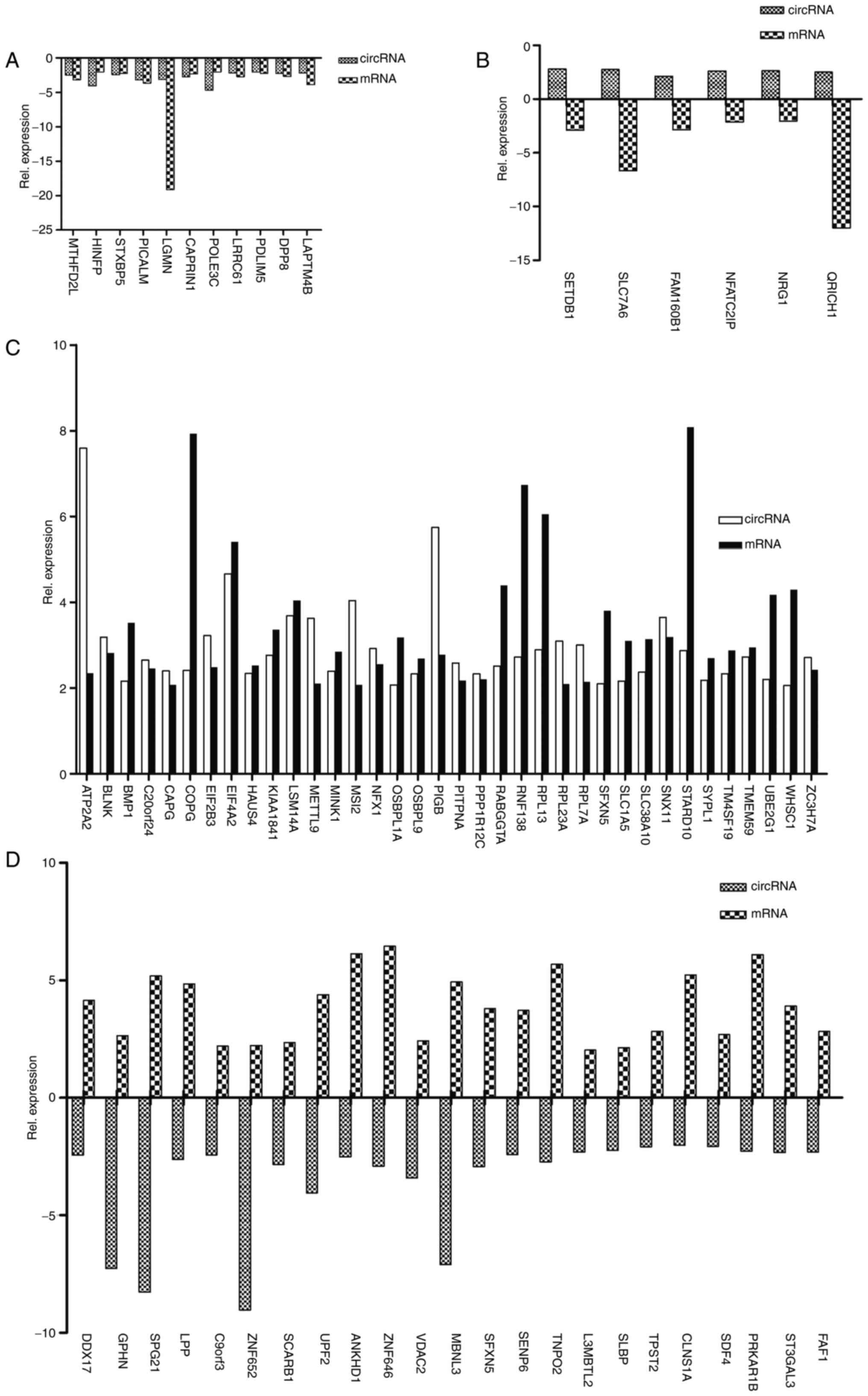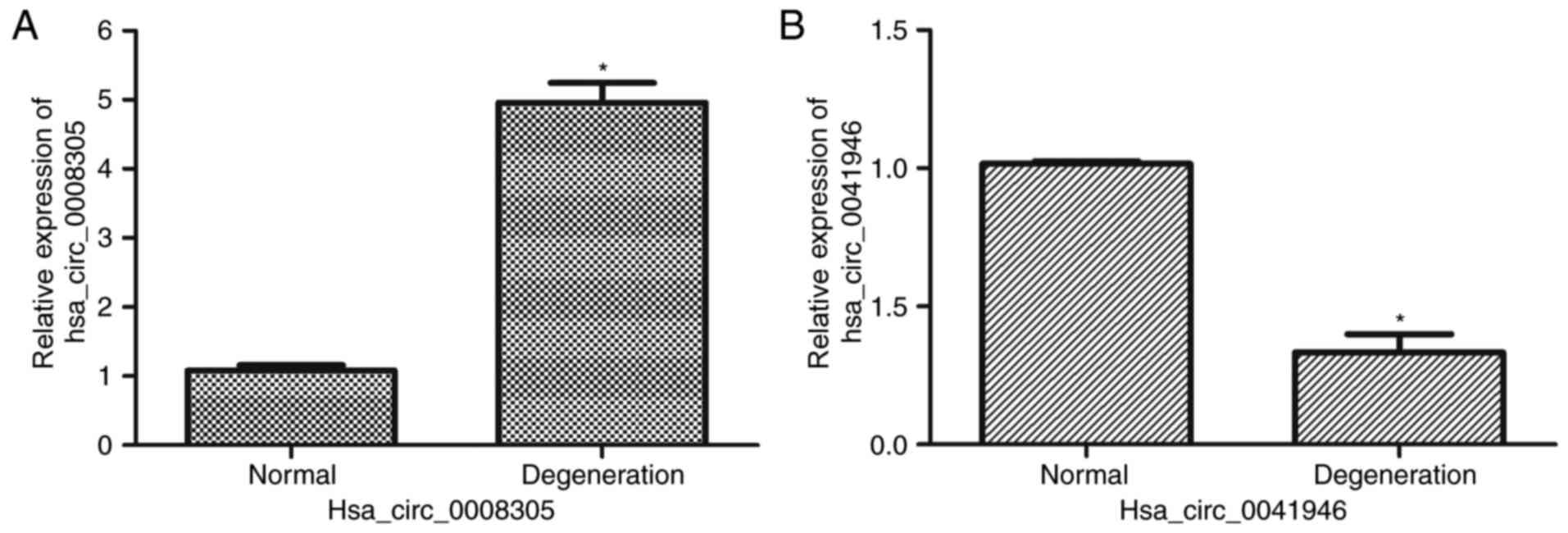Confirmation and preliminary analysis of circRNAs potentially involved in human intervertebral disc degeneration
- Authors:
- Published online on: October 4, 2017 https://doi.org/10.3892/mmr.2017.7718
- Pages: 9173-9180
Abstract
Introduction
Intervertebral disc degeneration (IDD) is a common chronic, age-related degenerative musculoskeletal disorder with a deleterious medical and social effect (1). Increasing evidence reveals that IDD incidence has been growing not only in elderly people but also in younger adults in the past decade (2). Genetic factors are the main contributing factor to IDD. Several studies demonstrate that single nucleotide polymorphisms, coding genes and noncoding RNAs serve important roles in IDD (3–7).
With the development of whole-genome sequencing studies, 98% of the human genome is now known to be transcribed into non-coding RNAs (ncRNAs) (8,9). NcRNAs can be divided into two subgroups in terms of their genomic function: Housekeeping and regulatory ncRNAs. Housekeeping ncRNAs include ribosomal RNA, transfer RNA, small nuclear RNAs and small nucleolar RNAs (10). Regulatory ncRNAs are composed of two groups based on the length of their transcripts. Small ncRNAs >200 nucleotides include microRNAs (miRNAs), small-interfering RNAs and Piwi-interacting RNAs (11). The other category is long non-coding RNAs (lncRNAs) (12,13). Circular RNAs (circRNAs) are a class of lncRNAs with covalently linked ends. Although there are not many studies on circRNAs, they have emerged as critical molecules in post-transcriptional regulation (14,15). CircRNAs can interact with miRNAs or proteins functioning as molecular sponges. In addition, CircRNAs can affect their host genes via cis- or trans-action (16). Recently, a study demonstrated that circRNAs can interact with polymerase (Pol) II machinery as positive regulators to regulate Pol II transcription (17–19). Overall, the interplay between circRNAs and the transcriptional machinery provides novel insights into strategies for regulating gene expression.
More recently, Lan et al (20) detected a combination of mRNA, miRNA, circRNA and lncRNA in the human lumbar disc using microarray analysis. This is the first discovery of circRNAs in the human lumbar disc by high-throughput methods. However, the potential roles of circRNA molecules in IDD remain unclear. To answer this question, circRNAs were classified by length in the present study and it was identified that they distributed uniformly in the human intervertebral disc. Subsequently, a functional enrichment analysis was performed, and confirmed tissue specific expression of the circRNAs host genes in IDD. Interactions of 76 pairs of circRNAs and their host genes were also demonstrated with potential to be used in the diagnosis and clinical treatment of IDD in the future.
Materials and methods
Human nucleus pulposus (NP) sample collection
Human lumbar NP specimens used as normal controls were collected from 10 patients (4 women and 6 men; mean age, 24.5 years; range, 20–36 years) that had idiopathic scoliosis and were undergoing deformity correction surgery. The degenerative human lumbar NP specimens were collected from 15 patients (5 women and 10 men; mean age, 37.2 years; range, 29–62 years) that had IDD and were undergoing disc excision and spinal fusion surgery. The degree of IDD was assessed according to the modified Pfirrmann grading system using preoperative MRI scans (21). The lumbar discs of all patients with IDD were classified as Grade III–V, and the discs of those with idiopathic scoliosis were classified as Grade I–II. The samples were used in RT-qPCR to validate the circRNAs microarray data. The study protocol was approved by the Clinical Research Ethics Committee of Huashan Hospital, Fudan University (Shanghai, China). Written informed consent was obtained from all participants.
Data source
The gene expression profile of GSE56081 and the circRNA expression profile of GSE67566 were downloaded from the NCBI GEO database (www.ncbi.nlm.nih.gov/geo).
Gene ontology (GO) analysis
Differentially expressed circRNAs and their host genes [which were ascertained using circbase database (http://circbase.org/)] were identified using the GEO database. Subsequently, the GO enrichment of these genes was analyzed using STRAP version no. 1.5 (http://www.bumc.bu.edu/cardiovascularproteomics/cpctools/strap/) with the default parameter settings.
Protein classification and pathways analysis
Protein classification and pathways analysis was obtained from the PANTHER Classifications Database (pantherdb.org/).
RNA isolation and reverse transcription-quantitative polymerase chain reaction (RT-qPCR)
TRIspin method was used to isolate total RNA of NP samples (22). Subsequently, RNA was reversely transcribed using the TransScript One-step gDNA Removal and cDNA Synthesis SuperMix kit according to the manufacturer's protocol (Beijing Transgen Biotech, Co., Ltd., Beijing, China). Expression of hsa_circ_0008305 and hsa_circ_0041946 were analyzed on the Bio-Rad IQ5 multicolor detection system with Power SYBR Green PCR Master Mix (Takara Bio, Inc., Otsu, Japan). The thermo cycling conditions for the RT-qPCR step is as follows: initial denaturation at 95°C, one cycle 2 min; 40 cycles of 95°C for 5 sec, 60°C, 30 sec; and final extension. The primers used were: Hsa_circ_0008305 forwards, 5′-AAATCGCTTTAAACCAACATC-3′ and reverse, 5′-CGGACACACGCCGTCTCTG-3′; hsa_circ_0041946 forwards, 5′-TGTGATGATGGTGAGGATGGG-3′, and reverse, 5′-GGCCTTGGAACTCAAGGATGC-3′; human GAPDH forwards, 5′-GGGAAACTGTGGCGTGAT-3′ and reverse, 5′-GAGTGGGTGTCGCTGTTGA-3′. Expression levels of the two circRNAs were normalized to GAPDH using the 2−ΔΔCq method (23).
Statistical analysis
RT-qPCR data are expressed as the mean ± standard error and evaluated with a two-tailed Student's t test. P<0.05 was considered to indicate a statistically significant difference. All experiments were repeated at least three times.
Results
Landscape of circRNA length in the human intervertebral disc
The study by Lan et al (20) demonstrated that circRNAs lengths in human intervertebral disc vary greatly, ranging from 74–433,729 nt. However, the distribution density of circRNA length is still not clear. In the current study, circRNAs from the GEO database were classified according to length and were distributed as follows in intervertebral discs: CircRNA containing >10,000 nt were at the highest level (29.34%), whereas circRNA containing 5,001–10,000 nt were at the lowest (14.79%); other lengths accounted for ~20% (Fig. 1). The distribution density of circRNA lengths in the intervertebral disc was very different from other organs like the heart, in which the majority of circRNAs are <501 nt (unpublished data). This result suggested that circRNA expression in humans is tissue-specific.
GO and classification analysis
To understand the potential roles of circRNAs, the GO categories of the host genes, which expressed the circRNAs were analyzed (Fig. 2). In the molecular function domain, the circRNA host genes were predominantly enriched in catalytic activity (39%) and binding terms (37%), and the remaining terms included receptor, structural molecule and transporter activity. In the cellular component domain, the highest host gene term was cell part (41%). Among the others, host genes were enriched in membrane, macromolecular complex, organelle and extracellular region terms. In biological process, host genes were part of the cellular (29%) and metabolic process terms (27%). In addition, the host genes were from the cellular component organization or biogenesis, localization, biological regulation, response to stimulus, developmental process, multicellular organismal process and immune system process terms.
To further understand the function of circRNAs in IDD, the host genes were classified on the basis of GO analysis. The genes were divided into 16 protein function classes and were ranked according to the percentage of proteins in the class (Fig. 3). Nucleic acid binding genes were ranked as the first (17.2%), and another class that included >10% of host genes was transcription factors (10.1%). In addition, transferases (9.5%), enzyme modulators (9.5%), hydrolases (8.9%) and transporters (8.7%) may also serve significant roles. These results are similar to those of the GO analysis.
Pathway analysis
To understand which signaling pathways the circRNAs are potentially involved in, the signaling pathways of host genes were analyzed. A total of 17 signaling pathways were obtained from the PANTHER Classifications Database (Fig. 4). The distribution of host genes in pathways was discrete, with the highest level reaching only 5.7%, which was the Wnt signaling pathway. The gonadotropin-releasing hormone receptor and integrin signaling pathways also contained a high level of host genes. In addition, the p53 pathway was associated with the lowest number of genes of the pathways investigated.
Interactions between circRNAs and their host genes
A recent study demonstrated that circRNAs could affect their host genes: Frequently there is a decrease in expression of linear mRNAs when the majority of transcribed exons are circularized, leading to a negative correlation between linear and circRNAs (24). Therefore, the co-expression of circRNAs and their host genes were analyzed. A total of 76 pairs of circRNAs and their host genes that were both differentially expressed in IDD were identified from the GEO databases (Fig. 5; Table I). They were divided into four classes of co-expression: Both circRNAs and their host genes downregulated, circRNAs upregulated and host genes downregulated, both circRNAs and their host genes upregulated, and circRNAs downregulated and host genes upregulated were detected. In the group with circRNAs and their host genes downregulated, there were 11 pairs of RNAs, and the majority were downregulated <5-fold (Fig. 5A). However, the Legumain mRNA was downregulated >15-fold (Fig. 5A). In the group with circRNAs upregulated and host genes downregulated, there were six pairs of RNAs, and all the RNAs, except glutamine-rich protein 1 (11.97-fold) and solute carrier family 7 member 6 (6.67-fold), were downregulated <3-fold (Fig. 5B). In addition, there were 36 pairs of RNAs in the group with both circRNAs and their host genes upregulated. The majority were upregulated <5-fold, but two circRNAs (circATP2A2 and circPIGB) and five mRNAs (coatomer protein complex subunit γ, eukaryotic translation initiation factor 4A2, ring finger protein 138, ribosomal protein L13 and StAR related lipid transfer domain containing 10) were upregulated by >5-fold (Fig. 5C). Additionally, 23 pairs of RNAs were in the group with circRNAs downregulated and host genes upregulated. All pairs of RNAs except for SPG21maspardin (13.46-fold), muscleblind-like splicing regulator 3 (12.02-fold) and zinc finger protein 652 (11.26-fold) were differentially expressed <10-fold (Fig. 5D). These results suggested that these 76 circRNAs may serve vital roles in regulating mRNAs in IDD (Table I).
Table I.A total of 76 differentially expressed circRNAs and their host genes in intervertebral disc degeneration. |
RT-qPCR validation
To validate the circRNAs microarray, one upregulated circRNA (hsa_circ_0008305) and one downregualted circRNA (hsa_circ_0041946) was selected randomly for further evaluation. RT-qPCR demonstrated that circ_0008305 was significantly upregulated (P<0.05) in degenerative disc samples compared with normal samples (Fig. 6A). Furthermore, hsa_circ_0041946 expression was reduced (P<0.05) in degenerative samples compared with control samples (Fig. 6B). This result suggested the circRNAs microarray data was credible.
Discussion
IDD is one of most common chronic and age-related degenerative musculoskeletal disorders, and one of the key factors leading to IDD is genetics (1–7). One class of recently discovered ncRNAs is circRNAs, which have been reported to be involved in IDD (20). In the present study, circRNAs were classified according to lengths, and it was demonstrated that different circRNA lengths were homogeneously distributed in the human intervertebral disc. Using functional enrichment analysis, the tissue-specific expression of circRNAs host genes in IDD was confirmed. By performing co-expression analysis, 76 pairs of differentially expressed circRNAs and their host genes were identified. Finally, RT-qPCR was performed to confirm hsa_circ_0008305 upregulation and hsa_circ_0041946 downregulation in IDD compared with normal lumbar NP specimens.
It has been reported that circRNAs have spatio-temporal features. Xia et al (25) identified >300,000 circRNAs in humans and mice, and 10.4% of human circRNAs and 34.3% of mouse circRNAs were tissue-specific. Werfel et al (26) identified 16,427 circRNAs in the human heart; however, only 2,202 of these were homologous to mouse circRNAs. The present analysis identified that circRNAs in the intervertebral disc are very different from heart circRNAs and that their lengths in the intervertebral disc are distributed uniformly. The results of the present study indicate that circRNAs may serve a key role in tissue development or disease occurrence.
In the process of IDD, extracellular matrix (ECM) metabolism becomes dysfunctional and the expression of growth factors and cytokines leads to inflammation (27). Subsequently, the ECM is degraded by catabolic factors (28). The GO data demonstrated that the circRNAs that interact with catalytic activity and binding genes are differentially expressed in IDD. The protein classification analysis illustrated that circRNAs that associated with genes that encode nucleic acid binding proteins, transferases, enzyme modulators and hydrolases maybe involved in IDD. All these results suggest that circRNAs may participate in ECM metabolism. However, the underlying molecular mechanisms need to be explored further.
Several signaling pathways have been reported to be involved in IDD, including the Wnt/β-catenin, the P53/P21, the interleukin, and the tumor growth factor-β pathways (26,29–33). These signaling pathways have important roles in regulating IDD. Notably, many host genes of the differentially expressed circRNAs in IDD are part of these pathways. For example, the circRNAs that bind mRNAs with roles in the Wnt signaling pathways were expressed in high levels. This result suggests that not only the mRNAs, but circRNAs in these signaling pathways serve key roles in IDD.
An important function of circRNAs is thought to be the regulation of mRNA expression. circRNAs may counteract miRNA-mediated repression or suppression of mRNA expression by competing with linear splicing (17,34). In total, 76 pairs of circRNAs and their host genes that could interact with each other were identified in IDD samples. Fas ligand, which mediates the apoptosis, was expressed in NP cells in IDD processes (35). Capping actin protein gelsolin like, a Fas apoptosis pathway gene, and its circRNA (hsa_circ_0055412) were both upregulated in IDD. However, the mRNA of another Fas pathway gene, Fas associated factor 1, was upregulated in IDD but its circRNA (hsa_circ_0004619) was downregulated. Growth factors serve important roles in IDD (36). Neuregulin 1 (NRG1) is a member of the epidermal growth factor receptor pathway that mediates cell-cell signaling and serves a critical role in growth and development (37). NRG1 mRNA was downregulated in IDD, but its circRNA (hsa_circ_0007279) was upregulated. Bone morphogenetic protein 1 (BMP 1) is another growth factor (38). BMP1 mRNA and circRNA (hsa_circ_0002075) were upregulated in IDD. These differentially expressed circRNAs may serve key roles in IDD and have the potential to be used in the diagnosis and clinical treatment of IDD in the future.
Acknowledgements
The present study was supported by the National Natural Science Foundation of China (grant no. 81601914 and 81472036).
References
|
Benjamin RW and Xuejun W: Intervertebral disc (IVD): Structure, degeneration, repair and regeneration. Mater Sci Engineer C. 32:61–77. 2012. View Article : Google Scholar | |
|
Deshpande BR, Katz JN, Solomon DH, Yelin EH, Hunter DJ, Messier SP, Suter LG and Losina E: Number of persons with symptomatic knee osteoarthritis in the US: Impact of race and ethnicity, Age, Sex, and Obesity. Arthritis Care Res (Hoboken). 68:1743–1750. 2016. View Article : Google Scholar : PubMed/NCBI | |
|
Song YQ, Karasugi T, Cheung KM, Chiba K, Ho DW, Miyake A, Kao PY, Sze KL, Yee A, Takahashi A, et al: Lumbar disc degeneration is linked to a carbohydrate sulfotransferase 3 variant. J Clin Invest. 123:4909–4917. 2013. View Article : Google Scholar : PubMed/NCBI | |
|
Gruber HE, Hoelscher GL, Ingram JA, Bethea S, Zinchenko N and Hanley EN Jr: Variations in aggrecan localization and gene expression patterns characterize increasing stages of human intervertebral disk degeneration. Exp Mol Pathol. 91:534–539. 2011. View Article : Google Scholar : PubMed/NCBI | |
|
Gruber HE, Hoelscher GL, Ingram JA and Hanley EN Jr: Genome-wide analysis of pain-, nerve- and neurotrophin-related gene expression in the degenerating human annulus. Mol Pain. 8:632012. View Article : Google Scholar : PubMed/NCBI | |
|
Sun Z, Wang HQ, Liu ZH, Chang L, Chen YF, Zhang YZ, Zhang WL, Gao Y, Wan ZY, Che L, et al: Down-regulated CK8 expression in human intervertebral disc degeneration. Int J Med Sci. 10:948–956. 2013. View Article : Google Scholar : PubMed/NCBI | |
|
Sun Z, Guo YS, Yan SJ, Wan ZY, Gao B, Wang L, Liu ZH, Gao Y, Samartzis D, Lan LF, et al: CK8 phosphorylation induced by compressive loads underlies the downregulation of CK8 in human disc degeneration by activating protein kinase C. Lab Invest. 93:1323–1330. 2013. View Article : Google Scholar : PubMed/NCBI | |
|
Brosnan CA and Voinnet O: The long and the short of noncoding RNAs. Curr Opin Cell Biol. 21:416–425. 2009. View Article : Google Scholar : PubMed/NCBI | |
|
Batista PJ and Chang HY: Long noncoding RNAs: Cellular address codes in development and disease. Cell. 152:1298–1307. 2013. View Article : Google Scholar : PubMed/NCBI | |
|
Jarroux J, Morillon A and Pinskaya M: History, discovery, and classification of lncRNAs. Adv Exp Med Biol. 1008:1–46. 2017. View Article : Google Scholar : PubMed/NCBI | |
|
Maxmen A: RNA: The genome's rising stars. Nature. 496:127–129. 2013. View Article : Google Scholar : PubMed/NCBI | |
|
Brown CJ, Ballabio A, Rupert JL, Lafreniere RG, Grompe M, Tonlorenzi R and Willard HF: A gene from the region of the human X inactivation centre is expressed exclusively from the inactive X chromosome. Nature. 349:38–44. 1991. View Article : Google Scholar : PubMed/NCBI | |
|
Bartolomei MS, Zemel S and Tilghman SM: Parental imprinting of the mouse H19 gene. Nature. 351:153–155. 1991. View Article : Google Scholar : PubMed/NCBI | |
|
Jeck WR, Sorrentino JA, Wang K, Slevin MK, Burd CE, Liu J, Marzluff WF and Sharpless NE: Circular RNAs are abundant, conserved, and associated with ALU repeats. RNA. 19:141–157. 2013. View Article : Google Scholar : PubMed/NCBI | |
|
Memczak S, Jens M, Elefsinioti A, Torti F, Krueger J, Rybak A, Maier L, Mackowiak SD, Gregersen LH, Munschauer M, et al: Circular RNAs are a large class of animal RNAs with regulatory potency. Nature. 495:333–338. 2013. View Article : Google Scholar : PubMed/NCBI | |
|
Greene J, Baird AM, Brady L, Lim M, Gray SG, McDermott R and Finn SP: Circular RNAs: Biogenesis, Function and role in human diseases. Front Mol Biosci. 4:382017. View Article : Google Scholar : PubMed/NCBI | |
|
Ashwal-Fluss R, Meyer M, Pamudurti NR, Ivanov A, Bartok O, Hanan M, Evantal N, Memczak S, Rajewsky N and Kadener S: circRNA biogenesis competes with pre-mRNA splicing. Mol Cell. 56:55–66. 2014. View Article : Google Scholar : PubMed/NCBI | |
|
Hansen TB, Jensen TI, Clausen BH, Bramsen JB, Finsen B, Damgaard CK and Kjems J: Natural RNA circles function as efficient microRNA sponges. Nature. 495:384–388. 2013. View Article : Google Scholar : PubMed/NCBI | |
|
Tay Y, Rinn J and Pandolfi PP: The multilayered complexity of ceRNA crosstalk and competition. Nature. 505:344–352. 2014. View Article : Google Scholar : PubMed/NCBI | |
|
Lan PH, Liu ZH, Pei YJ, Wu ZG, Yu Y, Yang YF, Liu X, Che L, Ma CJ, Xie YK, et al: Landscape of RNAs in human lumbar disc degeneration. Oncotarget. 7:63166–63176. 2016. View Article : Google Scholar : PubMed/NCBI | |
|
Pfirrmann CW, Metzdorf A, Zanetti M, Hodler J and Boos N: Magnetic resonance classification of lumbar intervertebral disc degeneration. Spine (Phila Pa 1976). 26:1873–1878. 2001. View Article : Google Scholar : PubMed/NCBI | |
|
Reno C, Marchuk L, Sciore P, Frank CB and Hart DA: Rapid isolation of total RNA from small samples of hypocellular, dense connective tissues. Biotechniques. 22:1082–1086. 1997.PubMed/NCBI | |
|
Livak KJ and Schmittgen TD: Analysis of relative gene expression data using real-time quantitative PCR and the 2(-Delta Delta C(T)) method. Methods. 25:402–408. 2001. View Article : Google Scholar : PubMed/NCBI | |
|
Huang S, Yang B, Chen BJ, Bliim N, Ueberham U, Arendt T and Janitz M: The emerging role of circular RNAs in transcriptome regulation. Genomics. Jun 26–2017.(Epub ahead of print). View Article : Google Scholar | |
|
Xia S, Feng J, Lei L, Hu J, Xia L, Wang J, Xiang Y, Liu L, Zhong S, Han L and He C: Comprehensive characterization of tissue-specific circular RNAs in the human and mouse genomes. Brief Bioinform: Agu. 20–2016.(Epub ahead of print). View Article : Google Scholar | |
|
Werfel S, Nothjunge S, Schwarzmayr T, Strom TM, Meitinger T and Engelhardt S: Characterization of circular RNAs in human, mouse and rat hearts. J Mol Cell Cardiol. 98:103–107. 2016. View Article : Google Scholar : PubMed/NCBI | |
|
Le Maitre CL, Pockert A, Buttle DJ, Freemont AJ and Hoyland JA: Matrix synthesis and degradation in human intervertebral disc degeneration. Biochem Soc Trans. 35:652–655. 2017. View Article : Google Scholar | |
|
Wang J, Markova D, Anderson DG, Zheng Z, Shapiro IM and Risbud MV: TNF-α and IL-1β promote a disintegrin-like and metalloprotease with thrombospondin type I motif-5-mediated aggrecan degradation through syndecan-4 in intervertebral disc. J Biol Chem. 286:39738–39749. 2011. View Article : Google Scholar : PubMed/NCBI | |
|
Jia H, Ma J, Lv J, Ma X, Xu W, Yang Y, Tian A, Wang Y, Sun L, Xu L, et al: Oestrogen and parathyroid hormone alleviate lumbar intervertebral disc degeneration in ovariectomized rats and enhance Wnt/β-catenin pathway activity. Sci Rep. 6:275212016. View Article : Google Scholar : PubMed/NCBI | |
|
Xie H, Jing Y, Xia J, Wang X, You C and Yan J: Aquaporin 3 protects against lumbar intervertebral disc degeneration via the Wnt/β-catenin pathway. Int J Mol Med. 37:859–864. 2016. View Article : Google Scholar : PubMed/NCBI | |
|
Zhou N, Lin X, Dong W, Huang W, Jiang W, Lin L, Qiu Q, Zhang X, Shen J, Song Z, et al: SIRT1 alleviates senescence of degenerative human intervertebral disc cartilage endo-plate cells via the p53/p21 pathway. Sci Rep. 6:226282016. View Article : Google Scholar : PubMed/NCBI | |
|
Wang Z, Wang G, Zhu X, Geng D and Yang H: Interleukin-2 is upregulated in patients with a prolapsed lumbar intervertebral disc and modulates cell proliferation, apoptosis and extracellular matrix metabolism of human nucleus pulposus cells. Exp Ther Med. 10:2437–2443. 2015. View Article : Google Scholar : PubMed/NCBI | |
|
Hiyama A, Sakai D, Tanaka M, Arai F, Nakajima D, Ab K and Mochida J: The relationship between the Wnt/β-catenin and TGF-β/BMP signals in the intervertebral disc cell. J Cell Physiol. 226:1139–1148. 2011. View Article : Google Scholar : PubMed/NCBI | |
|
Cortes-López M and Miura P: Emerging functions of circular RNAs. Yale J Biol Med. 89:527–537. 2016.PubMed/NCBI | |
|
Kaneyama S, Nishida K, Takada T, Suzuki T, Shimomura T, Maeno K, Kurosaka M and Doita M: Fas ligand expression on human nucleus pulposus cells decreases with disc degeneration processes. J Orthop Sci. 13:130–135. 2008. View Article : Google Scholar : PubMed/NCBI | |
|
Masuda K, Oegema TR Jr and An HS: Growth factors and treatment of intervertebral disc degeneration. Spine (Phila Pa 1976). 29:2757–2769. 2004. View Article : Google Scholar : PubMed/NCBI | |
|
Garratt AN, Britsch S and Birchmeier C: Neuregulin, a factor with many functions in the life of a schwann cell. Bioessays. 22:987–996. 2000. View Article : Google Scholar : PubMed/NCBI | |
|
Sedlmeier G and Sleeman JP: Extracellular regulation of BMP signaling: Welcome to the matrix. Biochem Soc Trans. 45:173–181. 2017. View Article : Google Scholar : PubMed/NCBI |



